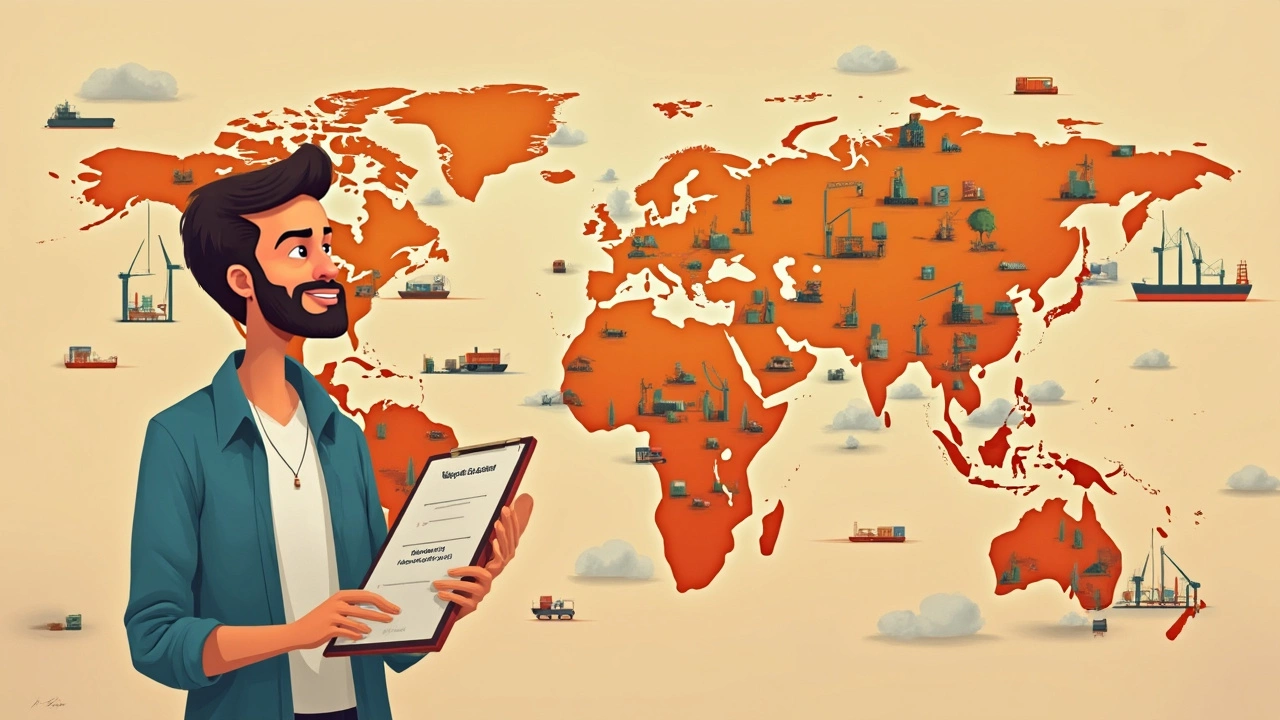Trying to figure out where to kick off your product manufacturing on a budget? The answer isn’t as simple as just picking the country with the lowest wages. Sure, places like Vietnam, India, and Bangladesh offer cheap labor, but that's just one piece of the puzzle.
Decisions about where to manufacture can make or break a startup. It’s not just about how little you can pay workers—it’s about shipping costs, taxes, local rules, and how quick you can get products out the door. For example, cutting corners on cost might land you with a factory that can’t hit your quality standards, or worse, suddenly increases prices after your first few orders.
Let’s break down what actually makes a place cheap (or expensive) for manufacturing. Knowing what you’re really paying for can help you dodge mistakes that burn cash and time. Real world tip: start early by asking potential partners for all-in quotes, not just a price per item. Watch out for surprise fees like shipping delays, customs, or regulatory headaches that pop up after you think the deal’s done.
- What Drives Manufacturing Costs?
- Top Countries for Low-Cost Manufacturing
- Hidden Expenses Most Startups Miss
- Tips When Choosing Where to Manufacture
What Drives Manufacturing Costs?
There’s more to the price tag than just hourly wages. To figure out the real cost of making your product somewhere, you’ve got to break things down like an accountant and think like a global traveler. Here's what really adds up:
- Labor Costs: Sure, labor is a big deal—countries like Bangladesh pay workers maybe $100 a month. But super low pay can also mean slower production or lower quality.
- Raw Materials: If your parts or materials aren't local, you’ll fork out cash for imports or long deliveries.
- Utilities & Overhead: Electricity, water, and rent can all be way more expensive in big cities or developed countries—especially for power-hungry factories.
- Shipping & Logistics: Getting stuff out of the factory and into your hands costs money. Being far from ports or in traffic-choked cities leads to delays and extra freight fees.
- Other Costs: Taxes, government rules, required insurance, and social security payments sneak into the bill. Sometimes, these cost more than wages.
Here’s a quick table showing why the “cheapest” place on paper may not end up so cheap:
| Country | Average Monthly Wage (Factory Worker) | Electricity Cost (cents/kWh) | Port Access/Shipping Time |
|---|---|---|---|
| Vietnam | $250 | 8 | Fast (major global ports) |
| India | $170 | 10 | Medium |
| Mexico | $400 | 12 | Fast (to US) |
| Bangladesh | $100 | 7 | Slow (infrastructure limits) |
Steven Ridley from the Manufacturing Leadership Council sums it up:
"The full cost to make a product isn’t just what you pay the worker. It's the sum of wages, materials, the cost to keep your lights on, and how fast you can get the product into your customer’s hands."
The most important thing? Don’t let the cheapest manufacturing promise on paper fool you into big bills later. Always run the numbers for your exact product and check if extra costs sneak in after you’ve started.
Top Countries for Low-Cost Manufacturing
Everyone’s looking for the best deal, so let’s put the spotlight on where manufacturing actually saves you the most money these days. Here are several countries that consistently hit those super-low-cost marks for labor, factories, and materials. If you want to keep overhead down, these are the places most startups and smaller brands are putting to good use.
- Vietnam has basically become the go-to spot for affordable and flexible manufacturing, especially for clothes, shoes, and electronics. Labor costs here average around $320 a month for factory workers, which is crazy low compared to US or European rates. Vietnam’s export infrastructure is getting better too, so shipping isn’t such a pain.
- India is a powerhouse for all sorts of goods—textiles, leather, consumer products, pharma, even auto parts. Wages run roughly $220 to $270 monthly on average for factory labor, and the government is aggressively pushing 'Make in India.' However, local red tape can slow things down if you’re not careful.
- Bangladesh has built its whole manufacturing base around ultra-low-cost clothing and textiles. It’s not uncommon for garment factories to pay around $120 to $170 monthly. But be sure to check up on working conditions and certifications, since quality and compliance are all over the map.
- Mexico may surprise you. It doesn’t offer rock-bottom wages (typically $450–$600/month for factory work), but it’s a hit for North American brands. Lower shipping costs, close time zones, and quicker deliveries often balance out the higher labor costs, especially for things like auto parts, electronics, and food products.
Here’s a quick glance at what matters most for a cheapest manufacturing strategy in 2025:
| Country | Avg. Monthly Factory Wage (USD) | Main Products | Why It’s Popular |
|---|---|---|---|
| Vietnam | $320 | Apparel, electronics, footwear | Low labor, growing infrastructure |
| India | $245 | Textiles, auto, pharma | Cheap labor, big talent pool |
| Bangladesh | $145 | Garments, textiles | Lowest labor, massive sector |
| Mexico | $525 | Auto, electronics, food | Close to US, lower freight |
A few other countries like Indonesia and Cambodia are worth mentioning for ultra-low wages, but think about things like infrastructure, reliability, and how easy it is to do business. Sometimes paying a bit more actually means a lot less hassle and fewer headaches when shipping worldwide.

Hidden Expenses Most Startups Miss
You might find a manufacturer offering super low prices, but nobody talks enough about the extra costs that show up after you’ve already signed. These hidden charges can turn the cheapest manufacturing dream into an unexpected money pit.
First up, shipping isn’t just the cost to send a box from point A to B. In 2024, container shipping rates from Asia to the US jumped over 50% in a few months because of supply chain hiccups. That’s wild if you forgot to plan for it. And that’s before you add insurance and port fees.
- Duties and Tariffs: Countries update their trade policies all the time. US tariffs on some Chinese goods jumped from 10% to 25% almost overnight in 2019 and are still hitting some product categories hard. If you’re not tracking this, your profit can vanish fast.
- Quality Control: Cheap doesn’t always mean good. Flying out inspectors or hiring quality firms can add a few thousand bucks per batch. Skipping this step is risky—failing a safety test in your main market could mean a product recall.
- Minimum Order Quantities (MOQs): Factories love volume. If you’re a small startup, you might be stuck ordering way more units than you can actually sell just to hit a minimum spend.
- Bureaucracy and Compliance: Legal documents, safety certifications, language translations—they’ll charge for these. Mess up a label or a customs form, and you’ll face delays or fines. The EU, for example, now fines up to €20,000 for missing some safety marks.
- Currency Fluctuations: Exchange rates shift fast. Between 2023 and 2024, the Indian rupee lost about 4% against the US dollar. If your payment isn’t locked in, you’ll pay more—sometimes a lot more—when the invoice comes due.
- Waste and Scrap: Not every item gets made right on the first go. Factories usually charge you for wasted material or failed test runs.
Here’s a quick look at some common extra costs, and how quickly they can add up:
| Expense | Typical Cost (per shipment or batch) | Startup Tip |
|---|---|---|
| Shipping (Asia to US/EU) | $2,000 - $10,000 | Lock in rates for at least 3 months if possible |
| Tariffs/Duties | 5% - 30% of invoice | Consult a trade expert before signing |
| Quality Inspections | $500 - $2,500 | Find local inspectors—travel is expensive |
| Compliance Certification | $300 - $5,000 | Always check local rules for your market |
| Currency Loss | 1% - 5% of payment | Use forward contracts when possible |
Always get a full breakdown from the supplier before you commit. Ask very direct questions and run your own numbers. It’s better to find out the truth now than write a painful check later.
Tips When Choosing Where to Manufacture
Picking where to actually make your stuff can be tricky, but there are a bunch of straightforward things that help narrow it down. Don’t just chase the lowest price tag—think bigger or you’ll pay for it later.
- Cheapest manufacturing countries often have hidden costs. Don’t just get quotes for assembly. Always ask for the full picture: labor, shipping, taxes, tariffs, packaging, and storage. For instance, a cheaper price per item in Bangladesh might be offset by higher shipping fees.
- Try to visit the factory, or send someone you trust. It’s wild how many startups get blindsided because a factory looked great online but cut corners in real life.
- Check communication and responsiveness. Can you get quick answers? Language barriers or time zone delays can make urgent fixes impossible.
- Quality control saves money long run. Countries like Vietnam and India have solid factories for electronics, textiles, and furniture, but quality can really vary. Always ask for factory certifications like ISO 9001 or social audits.
- Consider infrastructure. Countries with good roads, ports, and airports (like China and Mexico) move your products out faster and with fewer headaches. If your goods get stuck waiting for customs, your savings can disappear fast.
- Think about political and economic stability. Low prices in places like Myanmar or Ethiopia might sound tempting, but local unrest or policy changes can trigger big delays or cost spikes. Check recent news before locking in any deal.
Here's a quick comparison table to make sense of the trade-offs:
| Country | Labor Cost (USD/hr) | Average Shipping Time to US (days) | Common Hidden Costs |
|---|---|---|---|
| Vietnam | $2.99 | 23 | Delays at ports, customs |
| India | $2.20 | 27 | Poor rural infrastructure |
| Mexico | $3.80 | 5 | Higher land transport, local taxes |
| Bangladesh | $1.90 | 30+ | Low automation, shipping holdups |
| China | $6.50 | 17 | Tariffs, stricter export rules |
One last tip: ask factories for contact info from past clients. Honest feedback from another startup saves more time and money than any website ever will. Remember, where you make your product doesn’t just affect price—it can shape your brand, reliability, and how fast you can grow.
